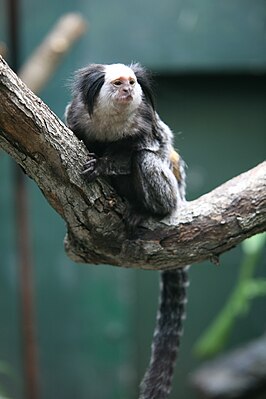Marmosets
| Marmosets | ||||||||||||
|---|---|---|---|---|---|---|---|---|---|---|---|---|

Bald marmoset ( Callithrix geoffroyi ) |
||||||||||||
| Systematics | ||||||||||||
|
||||||||||||
| Scientific name | ||||||||||||
| Callitrichini | ||||||||||||
| Thomas , 1903 |
The marmosets (Callitrichini) are a genus group from the primate family of the marmosets (Callitrichidae). They comprise about 20 species in the four genera marmosets ( Callithrix ), marmoset ( Mico ), Black Crown Marmoset ( Calli Bella ) and Pygmy Marmoset ( Cebuella be divided). The name marmosettes comes from the French marmouset , which means grotesque figure.
features
Like all marmosets, marmosets are relatively small primates, with the pygmy marmoset also the smallest representative of the real monkeys . They reach a head body length of 12 to 30 centimeters, the tail is 17 to 40 centimeters long and the weight varies between 85 and 470 grams. Their fur is short and dense, its color ranges from white to gray and brown to black, sometimes the head, the rear part of the trunk, the limbs or the tail are colored in contrasting colors. Some representatives have ear tufts. The limbs are rather short, as in all marmosets there are claws instead of nails on the fingers and toes (with the exception of the big toe).
Marmosets show a unique specialization of the dentition. The incisors are enlarged and the canines reduced in size so that all front teeth are about the same height. The incisors are - similar to those of rodents - chisel-like, as the thin layer of enamel on the inside wears off quickly. These specialized bits are used to gnaw holes in the tree bark in order to get to tree sap.
distribution and habitat
Marmosets are native to South America. The majority of the species live in the Amazon basin south of the Rio Japurá and the Amazon in northern Brazil , some also in neighboring regions (southern Colombia , eastern Ecuador , eastern Peru and northern Bolivia ). Only the marmosets are found in eastern and south-eastern Brazil.
The habitat of these animals are forests, where they can be found in both rain and dry forests. They prefer secondary forests and forest edge areas that are densely overgrown with undergrowth. They are relatively adaptable and can sometimes also be found in plantations and gardens.
Way of life
Like all marmosets, marmosets are active during the day, at night they sleep in thickets of plants or in tree hollows. In the branches they move on all fours or jumping, thanks to their claws they can also climb up vertical trunks easily.
They live in groups of two to 15 animals. In captivity, they can only be kept in monogamous family groups; in the wild they sometimes occur in larger, more complex groups with several adult males and females. Only the dominant female in a group will breed. In common marmosets, the ovulation of the subordinate females is suppressed, so that they are unable to reproduce.
food
Tree sap, which they can access with their specialized teeth, is an important or even the main component of the diet of many marmosets. They also eat fruits and other plant components as well as insects and other small animals, sometimes also vertebrates.
Reproduction
After a gestation period of around 130 to 150 days, the female usually gives birth to dizygoti twins. The young are very large at birth and reach around 25% of the weight of the mother. The father and the other group members participate intensively in raising the young, they carry them, occupy themselves with them and give them to the mother only to suckle. The reproduction rate is high, the female can give birth again just five to eight months after birth. The young are weaned at a few months and sexually mature at one to one and a half years.
Systematics
A total of more than 20 species are differentiated, with the marmoset reports of new, not yet scientifically described species.
-
Marmosets ( Callithrix )
- Common marmoset ( Callithrix jacchus )
- Yellow-bored tufted monkey or white brush monkey ( Callithrix aurita ).
- Bald marmoset ( Callithrix geoffroyi )
- Yellow-headed marmoset ( Callithrix flaviceps )
- Black marmoset or black brush monkey ( Callithrix penicillata )
- Great cow's marmoset ( Callithrix kuhlii )
-
Marmoset ( Mico )
 The silver monkey is a representative of the silk monkey.
The silver monkey is a representative of the silk monkey. The pygmy marmoset is the smallest representative of the marmosets and the smallest dry- nosed monkey at all.
The pygmy marmoset is the smallest representative of the marmosets and the smallest dry- nosed monkey at all.- Acari marmosets ( Mico acariensis )
- Silver monkey ( Mico argentata )
- Yellow and white marmoset ( Mico chrysoleuca )
- Brown marmoset ( Mico emiliae )
- White-shouldered marmoset ( Mico humeralifera )
- Aripuanã marmoset ( Mico intermedia )
- White marmoset ( Mico leucippe )
- Marca marmoset ( Mico marcai )
- Maués marmoset ( Mico mauesi )
- Black-tailed marmoset ( Mico melanura )
- Mico munduruku
- Black-headed marmoset ( Mico nigriceps )
- Rondonia marmoset ( Mico rondoni )
- Sateré marmoset ( Mico saterei )
- Genus Callibella
- Black-crowned marmoset ( Callibella humilis )
- Genus Cebuella
- Pygmy marmoset ( Cebuella pygmaea )
Your closest relative among the marmosets is probably the jumping tamarin .
literature
- Thomas Geissmann : Comparative Primatology. Springer-Verlag, Berlin et al. 2003, ISBN 3-540-43645-6 .
- Ronald M. Nowak: Walker's Mammals of the World. 6th edition. Johns Hopkins University Press, Baltimore MD 1999, ISBN 0-8018-5789-9 .
- Don E. Wilson , DeeAnn M. Reeder (Eds.): Mammal Species of the World. A taxonomic and geographic Reference. Johns Hopkins University Press, Baltimore MD 2005, ISBN 0-8018-8221-4 .

